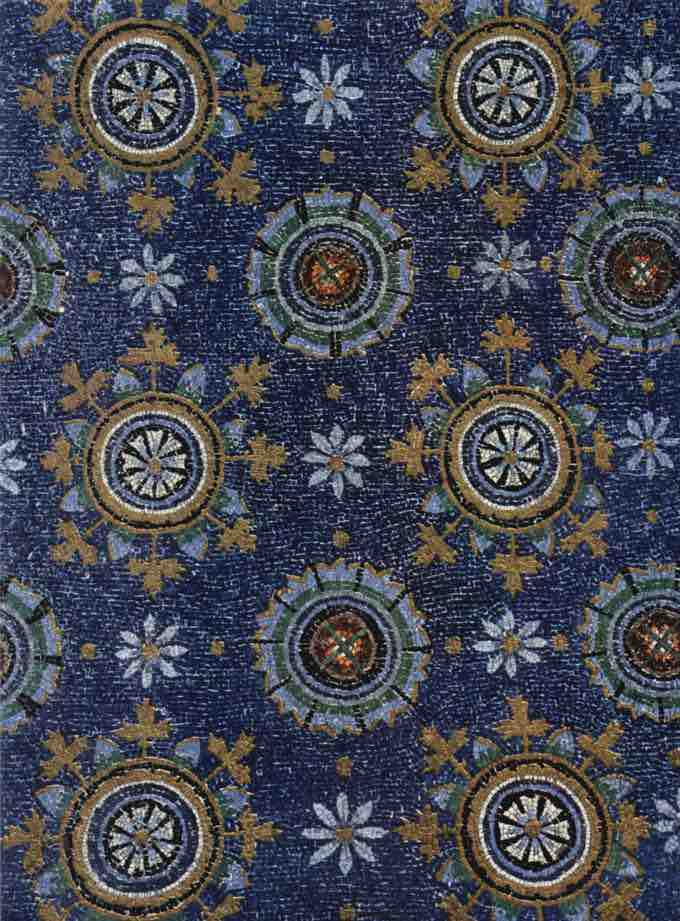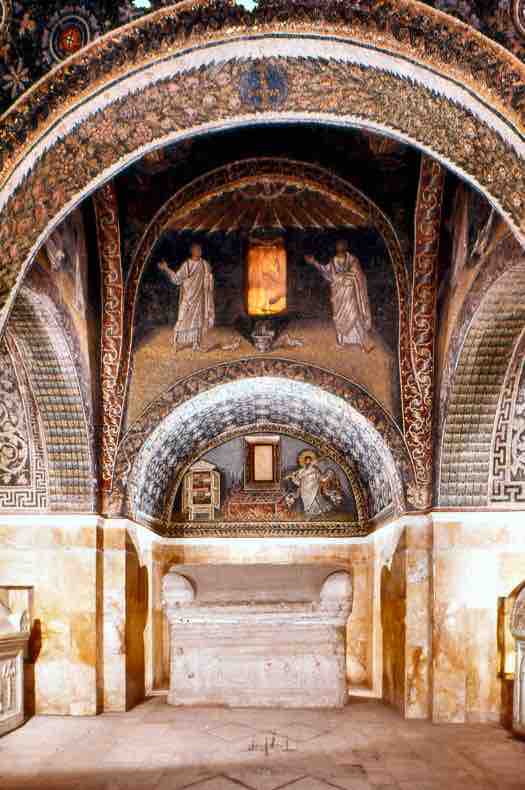Mosaic art flourished in the Byzantine Empire from the sixth to the fifteenth centuries. Whereas in Antiquity, walls were usually decorated with less-expensive painted scenes, the Byzantine aesthetic favored the more sumptuous, glittering effect of mosaic decoration. Some of the finest surviving Byzantine mosaics are preserved in the Middle East and in the Italian city of Ravenna. Mosaics were not a Byzantine invention. In fact, some of the most famous surviving mosaics are from ancient Greece and Rome.
Artists of the Early Byzantine period expanded upon precedent by celebrating the possibilities of the mosaic technique. They began to use it on wall surfaces as somewhat of a painting technique in stone. Unlike traditional wall paintings, however, mosaics could create a glittering, shimmering effect that lent itself to a heightened sense of spirituality. The imagery befit Byzantine culture, which emphasized the authority of one true religion.
The mosaic technique was more expensive than traditional wall painting, but its effects were so desirable as to make it worth the cost. Further, technological advances (lighter-weight tesserae and a new cement recipe) made wall mosaics easier than they had been in the preceding centuries, when floor mosaics were favored. The mosaic technique involved fitting together small pieces of stone and glass (tesserae). When set together, the tesserae create a paint-like effect in which different colors meld into one another to create shadows and a sense of depth. Moreover, Byzantine artists often placed gold backing behind the clear glass tesserae such that the mosaics would appear to emit a mysterious light of their own. This play of light added a sense of drama and spiritualism to the images that suited the symbolism and magic inherent in the Byzantine religious ceremony.
Mount Nebo, Jordan
Most often, however, mosaic decoration in the classical world was reserved for floor surfaces. Byzantine churches continued this tradition in locations such as Mount Nebo in Jordan, a medieval pilgrimage site where Moses is believed to have died. The Church of Saints Lot and Procopius (founded 567 CE) has a richly tiled floor depicting activities like grape harvest. Seemingly mundane, the grape harvest could be symbolic of the wine component of the Eucharist. The mosaic is located in the baptistery, where infants were initiated into the Christian faith and, according to biblical teachings, be cleansed of Original Sin. Thus, a symbolic depiction of the next sacrament in the religion would help to underscore the theme of salvation.
Another Mount Nebo floor mosaic (c. 530) depicts four registers of men and animals. The first two registers are hunting scenes in which the men hunt big cats and wild boars with the help of domesticated dogs. On the bottom two registers, the animals appear more domesticated, peacefully eat fruit from trees as a shepherd observes them at the left and wear leashes pulled by their human masters. Among the domesticated animals are a camel and what appear to be a zebra and an emu. As in the Church of Saints Lot and Procopius, this mosaic likely has a religious message beneath its seemingly mundane subject matter.
Floor Mosaic from Mount Nebo
Hunting and grazing scenes from a floor mosaic. Mount Nebo. c. 530 CE.
Monastery of Saint Catherine, Mount Sinai
Important Justinian era mosaics (c. 565-66) decorated the Saint Catherine's Monastery on Mount Sinai. In the apse is a depiction of the Transfiguration on a golden background, denoting the otherworldliness of the event. Christ, standing in the center as the focal point, is crowned with a halo and surrounded by a mandorla as his awestruck apostles observe the event. The apse is surrounded with bands containing medallions of Biblical apostles and prophets, and two contemporary figures identified as Abbot Longinos and John the Deacon.
Transfiguration of Jesus
Apse of the monastery of Saint Catherine, Mount Sinai, Egypt. c. 565-66 CE.
Ravenna
Arian Baptistery
Inside the Arian Baptistery in Ravenna are four niches and a dome with mosaics, depicting the baptism of Jesus by Saint John the Baptist. Although the mosaics were produced before Justinian I annexed Italy to the Byzantine Empire, their overall design is very similar to those produced under Byzantine rule. Jesus is shown as a beardless, half-submerged youth in the Jordan River. John the Baptist, wearing a leopard skin, stands on the right, while the personification of the Jordan River stands to the left. Above, the Holy Spirit in the form of a dove sprays holy water from its beak. Below, a procession of the Apostles, led in separate directions by Saint Peter and Saint Paul circle the dome, meeting at a throne with a bejeweled crucifix resting on a purple cushion.
Baptism of Jesus
Arian Baptistery, Ravenna, Italy. Late fifth-early sixth century.
It took the artists several years to complete these mosaics, as can be clearly seen from the different colors of the stones used to depict the grass at the feet of the apostles. The designs are quite simple, but the use of a gold background should be noted, as it was typically used in this era to infuse these simple scenes with an ethereal glow.
Mausoleum of Galla Placidia
The Mausoleum of Galla Placidia is one of the earliest Byzantine buildings in Ravenna. While the exterior is plain, the interior is extensively decorated in elaborate mosaics. These mosaics create a truly spiritual space–a world removed from the ordinary. The vaulting is covered with floral motifs (possibly symbolic of the Garden of Eden) and stars that stand out against a blue background even seeming to sparkle with their own mystical light.

Ceiling Mosaic at the Mausoleum of Galla Placidia
The Byzantines more creatively and liberally than other cultures in the classical world.
Mosaics cover the walls of the vault, the lunettes and the bell tower. The iconographic themes developed in the decorations represent the victory of eternal life over death. The inside contains two famous mosaic lunettes, and the rest of the interior is filled with mosaics of Christian symbols. The central bay's upper walls are decorated with four pairs of apostles, including Saints Peter and Paul, acclaiming a giant gold cross in the center of the dome against a blue sky of stars. Symbols of the four evangelists float among the clouds. The other four apostles appear in the barrel vaults of the transepts.

Internal View of Mausoleum of Galla Placidia
This early Byzantine structures demonstrates the intricate use of mosaics in Byzantine design.